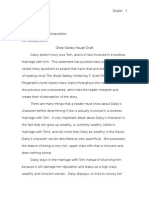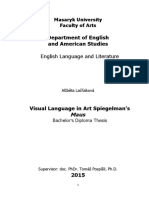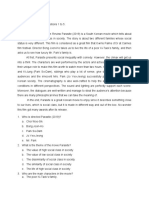Gatsbyecocriticalessay
Gatsbyecocriticalessay
Uploaded by
api-335704476Copyright:
Available Formats
Gatsbyecocriticalessay
Gatsbyecocriticalessay
Uploaded by
api-335704476Original Title
Copyright
Available Formats
Share this document
Did you find this document useful?
Is this content inappropriate?
Copyright:
Available Formats
Gatsbyecocriticalessay
Gatsbyecocriticalessay
Uploaded by
api-335704476Copyright:
Available Formats
1
Saeed Djalilov, Phillip Hancock, Pooja Ramaswamy, Jensen Risko
10 October, 2016
IB English HL-1
Mr. Shipley/Ms. Kestenbaum
Gatsby Ecocritical Analysis
F. Scott Fitzgeralds 1925 novel, The Great Gatsby remains a masterpiece today in part
due to its versatility. While the nature of literary lenses is to be applicable to any work, the book
has so much depth that even modern lenses can be easily applied to it. Ecocriticism is a fairly
new lens, and was certainly created long after The Great Gatsby. Still, there are distinct
ecocritical connections within the novel, such as a potential interpretation of it as a tree, as both
of the entities could be analyzed deeper than people initially observe. The motifs present in the
novel, the characters they affect, and the ways they interact with nature all reflect the destructive
capacity of the American Dream when viewed through an ecocritical lens.
Money can be seen as the root of everything in a modern capitalist society, much like the
roots of a tree. The tendrils spread out for miles underneath the ground, connecting thousands of
other organisms. This parallels real life, as money affects everything, regardless of the subjects
will. In the novel, money motivates the characters to pursue different versions of the same goal.
Everyone is driven by money, and the desire to obtain it pushes the plot forward, as well as
propping up the background of the characters. This concept of greed stems directly from nature.
While you could argue that humans have a natural desire for greed inherent in their existence, it
is also possible to justify greed as a natural idea due to the elements that compose the object that
motivates it. The bills and coins that represent so much are just metal or cotton symbols,
reflecting an idea of something more- but the items themselves are made up of natural elements.
Ironically, the natural concept of greed helps destroy nature. Within the novel, Nick laments the
loss of nature as a result of humanitys greed. And as the moon rose higher the inessential
houses began to melt away until gradually I became aware of the old island that flowered here
once for Dutch sailors' eyes - a fresh green breast of the new world. Its vanished trees, the trees
that had made way for Gatsby's house, had once pandered in whispers to the last and greatest of
all human desires (Fitzgerald 180). This quote suggests that the lush forest that once existed on
Long Island has now been destroyed in order to make way for human profit. Human greed was
enough to eradicate a mysterious, wonderful wood, replacing it with residences specifically made
to please humans. Nick, in a spiritual moment, sees past the development and to the lands purest
form, he then realizes that nature has resigned itself to the greatest of all human desires: greed.
The color green is mentioned heavily in the quote. The color green is often connected to greed,
as green is the color of US dollars. The unnoticed natural world that lies beneath West Egg in
The Great Gatsby is also described as the color green, representing the greed and lust for wealth
that left West Egg in the state it is now.
Humans are the ones who are affected by this concept of greed and money and allow it to
take root in society through their actions. For this reason, the characters of the novel can be seen
as the trunk of the tree. Just as in real life, the characters in the novel are driven by their desire
for money. This desire is also what drives their actions and dreams. If the roots were dead, the
trunk would not exist. Similarly, if money did not exist, the characters in the novel would not
either. In the novel there are many scenes that show the character's effect on the environment
and vice versa, many of which spring from their monetary desires. The concept of pathetic
fallacy, a literary device in which the environment reflects the lives of characters, also plays a
huge part in how nature and the characters interact. Tensions arose between Tom and Gatsby
partly due to the weather, that Nick describes,The relentless beating heat was beginning to
confuse me and I had a bad moment there before I realized that so far his suspicions hadn't
alighted on Tom (Fitzgerald 124). Through this quote, the reader sees why Gatsby and Tom
exploded so easily during that day. The type of weather greatly affects the moods of the
characters, since Gatsby ultimately loses his cool in the hotel room when he was confronting
Tom about Daisys love. The physical and metaphorical heat of the situation reflects the
instability of the evolving industrialized world, and how the characters in the novel disregard
concerning situations until they explode.
This is not the only circumstance however where pathetic fallacy is used to parallel the
characters and the world. When Gatsby meets Daisy for the first time, Nick describes the
weather: Once more it was pouring, and my irregular lawn, well-shaved by Gatsby's gardener,
abounded in small muddy swamps and prehistoric marshes (Fitzgerald 88). The rain represents
the sadness Gatsby feels in talking to Daisy for the first time, especially after Nick criticized him
for being rude, while the sticky mud shows the slow-going, awkward conversation that Daisy
and him are having. But only around half an hour later, Nick describes, The sun shone again,
and the grocers automobile rounded Gatsbys drive with the raw material for his servants
dinner (Fitzgerald 88). Suddenly the sun came out, and when Nick decides to return he finds
that Gatsby and Daisy are holding wonderful conversation. The weather reflected the course of
Gatsbys conversation, but the situation as a whole reflects how something as simple as weather
can affect humans mood.
The characters in the story are the driving force of all of the main motifs in the novel.
These motifs exist as a result of the characters, which is why these themes can be looked at as
branches of a tree, on the end being the leaves, which are the concept of the American Dream.
The American Dream can be seen this way due to each person having a unique dream as well as
a different way to achieve said dream. All of these dreams, however, no matter what they are,
are achieved by acting in accordance with the motifs in the novel. The money-crazy characters
engage in crime to get money, to drink alcohol, to throw parties, and to generally disregard the
well being of the environment as they are driven by their American Dreams. All the characters
are too caught up in their heads to stop and look after their environment. The characters lives
take place during a time where humans were beginning to take leaps into damaging the
environment by rapidly industrializing, constructing coal mines, automobiles, and factories. The
life goal to fulfill the American Dream was rarely achieved, but the characters do not realize this,
instead distracting themselves rather than paying attention to the important issues of the
environment. Gatsby realizes this right before his death: If that was true he must have felt that
he had lost the old warm world, paid a high price for living too long with a single dream. He
must have looked up at an unfamiliar sky through frightening leaves and shivered as he found
what a grotesque thing a rose is and how raw the sunlight was upon the scarcely created grass. A
new world, material without being real, where poor ghosts, breathing dreams like air, drifted
fortuitously about... like that ashen, fantastic figure gliding toward him through the amorphous
trees (Fitzgerald 161). Just as Nick does at the end of the novel, Gatsby takes a good look at his
surroundings and realizes how shallow they are. He lost the warm old world, got too
disconnected from nature to even recognize it, being frightened by the leaves and confused by
how unfamiliar the sky looked. He spent his entire life chasing a dream, and in it lost himself,
destroying the world around him to achieve his goal.
All of the themes and motifs of the novel come together to make a tree. At the roots lie
money, which drives the characters to destroy their surroundings for their own personal gain.
This money is handled by the characters, which represent the trunk- one of the most important
structures in the tree, connecting the roots and the branches while supporting its structure. Those
branches and the leaves they connect to represent the motifs and the American Dream
respectively, with the motifs being the conduits in which the American Dream can be attained by
the characters. The great irony behind this is that the natural figure of the tree represents the
destructive capacity of humans towards nature, as all the themes within it contribute to how the
characters hurt the environment. If our generation, unlike the generation depicted in The Great
Gatsby, was more attentive to our surroundings, issues that threaten the wellbeing of the planet
would not arise. Humans often believe they are helping by being productive members of society
and by working nonstop, but the greatest action they might take in a full work day is simply
picking up a piece of trash outside. The human race has the capacity to destroy in order to
achieve their dreams, but with a little bit of effort it is possible to fulfill them and aid our Mother
Nature.
You might also like
- From The (Aethiopica) To The Renaissance Recovering A Stage Tradition of Positive Representation of Africans in Early Modern England by Margarette SinclairDocument256 pagesFrom The (Aethiopica) To The Renaissance Recovering A Stage Tradition of Positive Representation of Africans in Early Modern England by Margarette Sinclairmail.test.ceetNo ratings yet
- Gatsby Essay Outline ExampleDocument2 pagesGatsby Essay Outline Exampleapi-25463394675% (4)
- A Floating ChinamanDocument287 pagesA Floating ChinamanÁlvaro Fernández Bravo50% (2)
- The Great Gatsby EssayDocument3 pagesThe Great Gatsby EssayJosh Rogan100% (3)
- GatsbyecocriticalessayDocument7 pagesGatsbyecocriticalessayapi-335700777No ratings yet
- Nick Carraway and The Imagery of DisorderDocument6 pagesNick Carraway and The Imagery of DisorderElisabetta PalmeriNo ratings yet
- Great Gatsby QuotesDocument3 pagesGreat Gatsby QuotesJeremy Keeshin88% (17)
- How Does Miller Present The Relationship Between Eddie and Marco Throughout The PlayDocument3 pagesHow Does Miller Present The Relationship Between Eddie and Marco Throughout The PlaySam ShohetNo ratings yet
- The Oxford History of The Novel in English - Volume 6 - The American Novel 1879-1940 (PDFDrive)Document656 pagesThe Oxford History of The Novel in English - Volume 6 - The American Novel 1879-1940 (PDFDrive)shiv100% (1)
- The Rise of The Novel (Part 1)Document2 pagesThe Rise of The Novel (Part 1)Adrian M. Anghel100% (2)
- The Treatment of Time in Tristram ShandyDocument2 pagesThe Treatment of Time in Tristram ShandyMarie StoieNo ratings yet
- Creative Nonfiction Q1 M1Document17 pagesCreative Nonfiction Q1 M1Pril Gueta94% (16)
- Q1 How Do Tom and Daisy Represent The Morality of The EstablishedDocument6 pagesQ1 How Do Tom and Daisy Represent The Morality of The EstablishedShowket IbraheemNo ratings yet
- Symbols in The Great GatsbyDocument3 pagesSymbols in The Great Gatsbytwisterboy42081% (16)
- Selma Slezovic SIR2 Great GatsbyDocument13 pagesSelma Slezovic SIR2 Great GatsbySelma Slezovic MehovicNo ratings yet
- Motif Essay For Great GatsbyDocument7 pagesMotif Essay For Great Gatsbytinyy209100% (1)
- Bookreportq3 2016-JolinasantosDocument2 pagesBookreportq3 2016-Jolinasantosapi-302911087No ratings yet
- Critical Context The Great GatbsyDocument15 pagesCritical Context The Great GatbsyAgata WójtowiczNo ratings yet
- Myrtle & DaisyDocument2 pagesMyrtle & DaisyMiss_M90No ratings yet
- Critical Article On The Great Gatsby 1 PDFDocument26 pagesCritical Article On The Great Gatsby 1 PDFAlba BrotonsNo ratings yet
- Death of A Salesman and The Great GatsbyDocument4 pagesDeath of A Salesman and The Great Gatsbyapi-273225467No ratings yet
- Great Gatsby Final DraftDocument10 pagesGreat Gatsby Final Draftapi-287044316No ratings yet
- The Questionable Narrator: Nick Carraway's Influence On The Great GatsbyDocument13 pagesThe Questionable Narrator: Nick Carraway's Influence On The Great GatsbyMoorea Moylan100% (1)
- Gatsby vs. of Mice and Men EssayDocument5 pagesGatsby vs. of Mice and Men EssayMyraSue Heather Cargal100% (9)
- Gatsby EssayDocument5 pagesGatsby Essayapi-332014923100% (1)
- The Picture of Dorian Gray and The Temple of The Golden PavilionDocument16 pagesThe Picture of Dorian Gray and The Temple of The Golden PavilionFarrel MaxNo ratings yet
- Great Gatsby Essay QuestionsDocument2 pagesGreat Gatsby Essay Questionsliz100% (2)
- Psychoanalytic CriticismDocument5 pagesPsychoanalytic CriticismArkan NaserNo ratings yet
- Kite Runner QuotesDocument5 pagesKite Runner Quotessamayramsumer100% (1)
- The Great GatsbyDocument5 pagesThe Great Gatsbyapi-439486896No ratings yet
- (Rida) Symbolism of Huckleberry FinnDocument2 pages(Rida) Symbolism of Huckleberry FinnUme lailaNo ratings yet
- Department of English and American StudiesDocument47 pagesDepartment of English and American StudiesSandra BotrosNo ratings yet
- What Is Nick's Role in The Great GatsbyDocument11 pagesWhat Is Nick's Role in The Great GatsbyDiana SribnayaNo ratings yet
- Discussion: His Verse Out Loud / in His Wolfy DrawlDocument3 pagesDiscussion: His Verse Out Loud / in His Wolfy DrawlgshzhvdvdNo ratings yet
- The Great Gatsby PLOTDocument16 pagesThe Great Gatsby PLOTLouise Aundrey PlacidoNo ratings yet
- The Great Gatsby - A TragedyDocument4 pagesThe Great Gatsby - A TragedyericsohngNo ratings yet
- ThegreatgatsbyDocument5 pagesThegreatgatsbyapi-355487841No ratings yet
- Gatsby Chapter 8-9Document6 pagesGatsby Chapter 8-9Mauricio HernandezNo ratings yet
- The Great GatsbyDocument6 pagesThe Great GatsbyAbhilekh Thapa MagarNo ratings yet
- Structure and Narration in The Great GatsbyDocument4 pagesStructure and Narration in The Great GatsbycyaanideNo ratings yet
- Pride and PrejudiceDocument32 pagesPride and PrejudiceAnara AbylkassovaNo ratings yet
- Study of Black Consciousness in A Raisin in The SunDocument4 pagesStudy of Black Consciousness in A Raisin in The SunRani JuttNo ratings yet
- The Great Gatsby Final EssayDocument2 pagesThe Great Gatsby Final EssayaBloomingTreeNo ratings yet
- The Scarlet Letter EssayDocument4 pagesThe Scarlet Letter Essayapi-305332070No ratings yet
- Naturalism The Open BoatDocument43 pagesNaturalism The Open BoatBrandon Michaels100% (1)
- Prisoner Who Wore Glasses QuestionsDocument2 pagesPrisoner Who Wore Glasses QuestionsGrace KellyNo ratings yet
- Jackson Lottery Literary AnalysisDocument12 pagesJackson Lottery Literary AnalysissontaylorNo ratings yet
- COM 263 Movie Analysis Paper "The Namesake"Document6 pagesCOM 263 Movie Analysis Paper "The Namesake"Michael Sully SullivanNo ratings yet
- Hard Times Charles DickensDocument4 pagesHard Times Charles DickensAndra GabrielaNo ratings yet
- Great ExpectationsDocument9 pagesGreat Expectationsshark777No ratings yet
- The American Dream in The Great GatsbyDocument6 pagesThe American Dream in The Great GatsbyDavid CoxNo ratings yet
- Great Gatsby QuotesDocument1 pageGreat Gatsby QuotesjonhollandNo ratings yet
- American Dream LiteratureDocument3 pagesAmerican Dream LiteratureKhanNo ratings yet
- Analysis Lady LazarusDocument8 pagesAnalysis Lady LazarusNoemiKissNo ratings yet
- Great Gatsby EssayDocument8 pagesGreat Gatsby EssayTom YelizarovNo ratings yet
- English Adv Notes Year 12Document58 pagesEnglish Adv Notes Year 12Felicity ArundellNo ratings yet
- The Love Song of J Alfred Prufrock (Introduction) (Encyclopaedia)Document10 pagesThe Love Song of J Alfred Prufrock (Introduction) (Encyclopaedia)Ritankar RoyNo ratings yet
- The Great Gatsby CharactersDocument3 pagesThe Great Gatsby CharactersChristine EngelbrechtNo ratings yet
- Development of Nick in Great GatsbyDocument4 pagesDevelopment of Nick in Great GatsbyladycaiNo ratings yet
- The Great Gatsby, A Doll's House and The Reluctant Fundamentalist AnalysisDocument3 pagesThe Great Gatsby, A Doll's House and The Reluctant Fundamentalist Analysissofia0% (1)
- The Great Gatsby Final DraftDocument4 pagesThe Great Gatsby Final Draftapi-494351686No ratings yet
- Great Gatsby Essay AssignmentDocument5 pagesGreat Gatsby Essay Assignmentapi-373613837No ratings yet
- The LotteryDocument9 pagesThe LotteryKSNo ratings yet
- Latihan Soal Review TextDocument5 pagesLatihan Soal Review TextFIRYAL HASNANo ratings yet
- Giáo Trình Văn Học MỹDocument81 pagesGiáo Trình Văn Học MỹHiền LêNo ratings yet
- Lesson 3: 21 Century Literature and in Early PeriodsDocument4 pagesLesson 3: 21 Century Literature and in Early PeriodsCharlesNo ratings yet
- Feminist Approach in Two Writers Bharati Mukherjee and Manju KapurDocument2 pagesFeminist Approach in Two Writers Bharati Mukherjee and Manju KapurInternational Journal of Research in Engineering and Technology100% (1)
- State of War: Unreading The Novel, or Experiencing Ninotchka Rosca'S As MythopoeiaDocument29 pagesState of War: Unreading The Novel, or Experiencing Ninotchka Rosca'S As MythopoeiaABRIA CLAIRENo ratings yet
- Novel - David CopperfieldDocument2 pagesNovel - David CopperfieldGabadadze JakobNo ratings yet
- Canon Formation RevisitedDocument20 pagesCanon Formation Revisitedaybala76No ratings yet
- Contemporary Arts M Odule 2Document9 pagesContemporary Arts M Odule 2Jam MarquitaNo ratings yet
- english 9 unit 5 HSDocument6 pagesenglish 9 unit 5 HSferb.25thNo ratings yet
- Setting and Description in Horror Fiction Extended Short Story WorkshopDocument6 pagesSetting and Description in Horror Fiction Extended Short Story WorkshopMinaEmadNo ratings yet
- Engleby:We Need To Talk About KevinDocument5 pagesEngleby:We Need To Talk About Kevinylozanochester20No ratings yet
- Bridge To Terabithia UnitDocument52 pagesBridge To Terabithia Unitapi-259090236No ratings yet
- EPISTOLARY Novel Used The Private and Personal Form of Letters To Tell ItsDocument7 pagesEPISTOLARY Novel Used The Private and Personal Form of Letters To Tell ItsprasannandaNo ratings yet
- 21st Century Literature LAS 4 Q3 M2Document8 pages21st Century Literature LAS 4 Q3 M2Edmar Barrido100% (3)
- Literary Genres: Flash Fiction Graphic FictionDocument24 pagesLiterary Genres: Flash Fiction Graphic FictionUmji Chingu88% (8)
- Romance ThesisDocument5 pagesRomance Thesiscarlamolinafortwayne100% (2)
- Learning Activity Sheet: I. ObjectiveDocument5 pagesLearning Activity Sheet: I. ObjectiveLarisha Frixie M. DanlagNo ratings yet
- Science Fiction in The Twentieth Century PDFDocument173 pagesScience Fiction in The Twentieth Century PDFFabricioParmindo100% (2)
- Ahdaf Soueif - The Unblushing Bourgeoise - Hind WassefDocument4 pagesAhdaf Soueif - The Unblushing Bourgeoise - Hind WassefzabitNo ratings yet
- The Realism and NaturalismDocument4 pagesThe Realism and NaturalismErvina NurNo ratings yet
- Dissertação - To Kill A Mockingbird BildungsromanDocument103 pagesDissertação - To Kill A Mockingbird BildungsromanRicardo Perez SilvaNo ratings yet
- Sawako Ariyoshi, The Doctor's Wife - Whispering GumsDocument4 pagesSawako Ariyoshi, The Doctor's Wife - Whispering GumsAdam DanialNo ratings yet
- Zaverchand MeghaniDocument10 pagesZaverchand Meghanikeval121220No ratings yet
- Eudora WeltyDocument1 pageEudora Weltyeudoraeudora1909No ratings yet

























































































